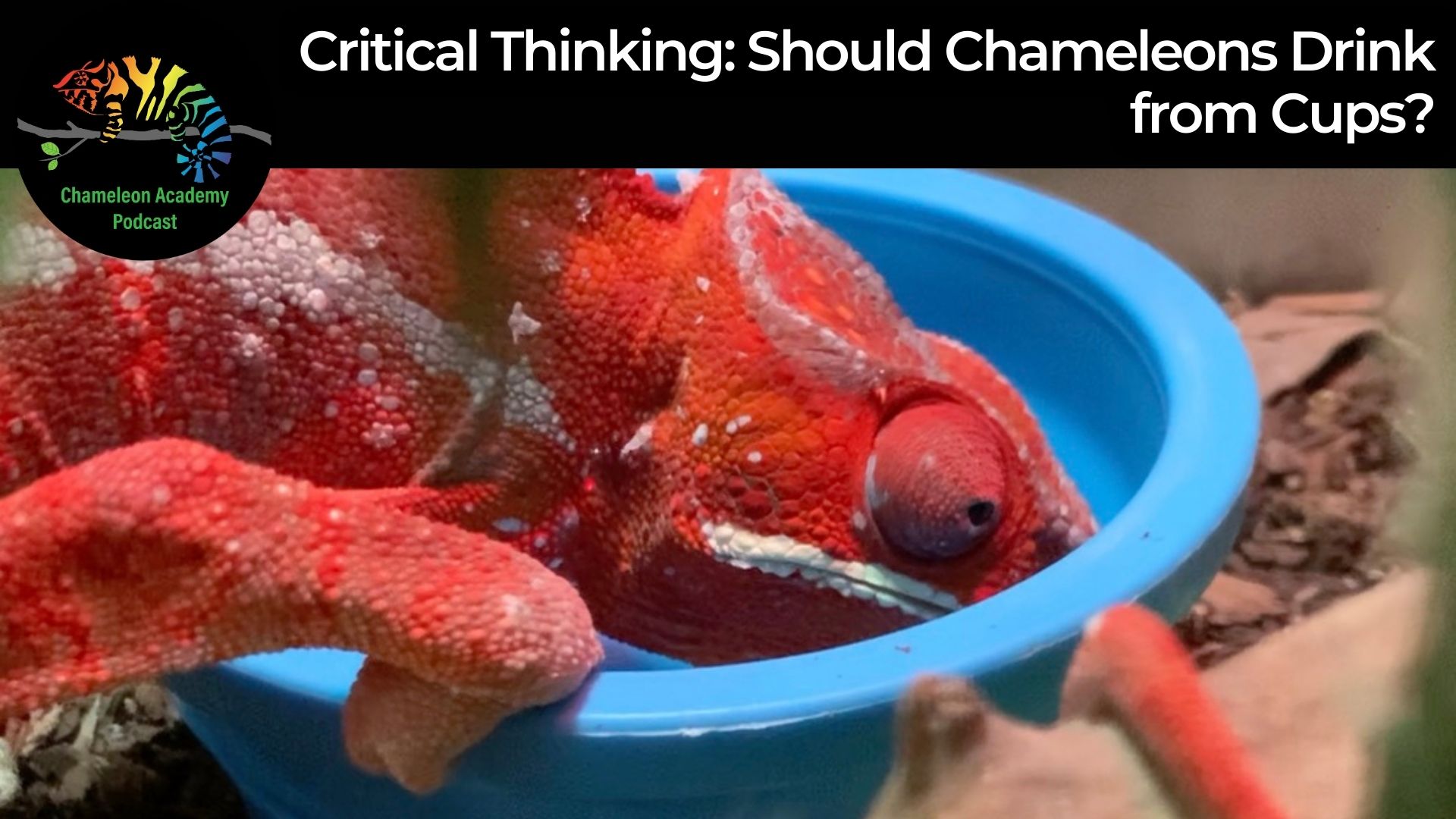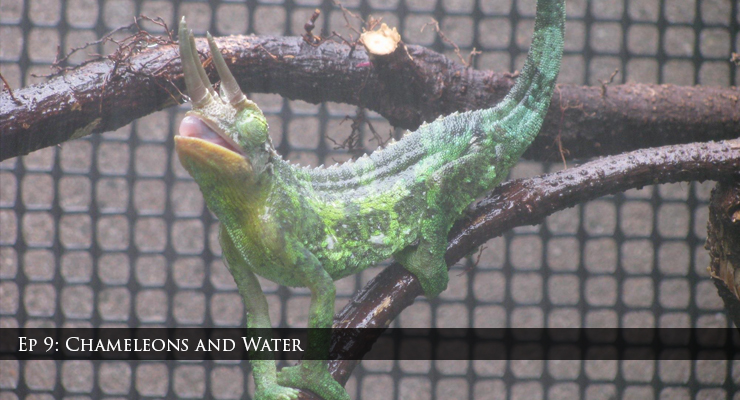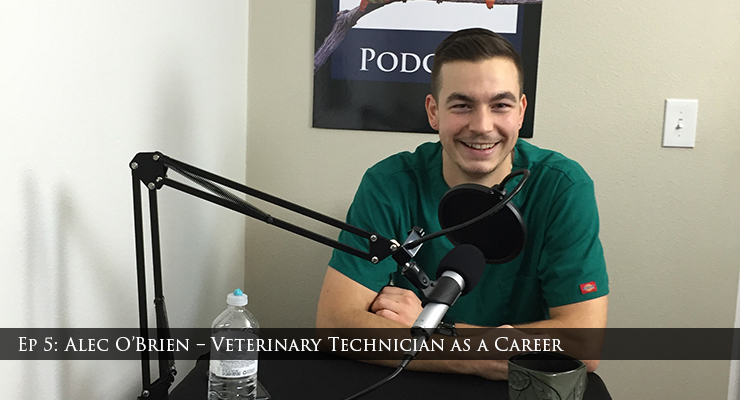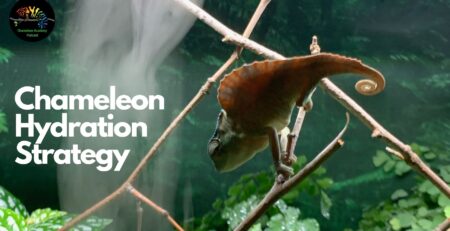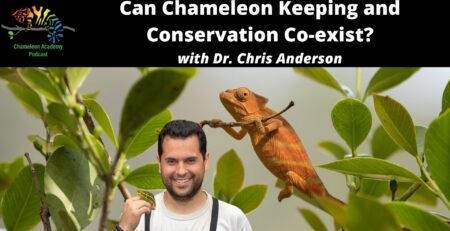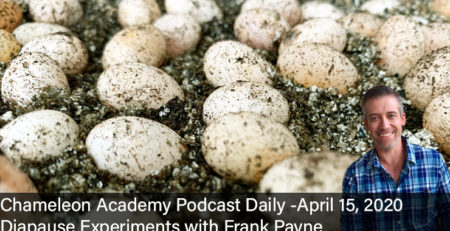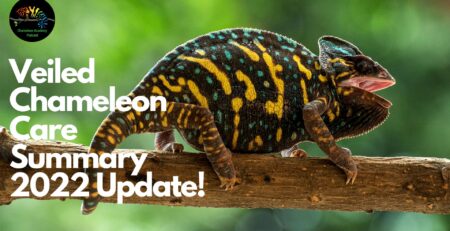S8 E3: Should We Give Chameleons Water Cups?
Whenever we are presented with a new idea our first reactions are often either to reject it because it would be too much work to think about changing or to get unnaturally excited with the feeling of being on the cutting edge of techniques. And so it is useful to have a standard by which we will evaluate new ideas.
This week I presented a set of questions I ask myself when presented with a new idea of how to do things. It is amazing how the closed nature of these many social media groups provides interesting evolutions of trains of thought. Depending on the group size, these ideas may or may not leak to the greater community.
One of these thoughts that has evolved apart from the main stream community is the the thought that not only is offering a chameleon a cup of water a viable hydration technique, but it should be the only technique because misting and dripping are dangerous. While the community may be divisive of this idea on general principle we should take a step back and evaluate it for its merits. Only by thinking about it more deeply can we understand how to talk with someone who was raised up in that environment and is exploring the outside world for the first time. This is a well known dynamic. People learn about chameleons in one group that is controlled by an admin team that constantly talks about how they know something the rest of the world doesn’t and so you shouldn’t listen to anything anyone else says. And when all the people around you agree, it is hard to look at what is going around the outside world. This is the dynamic that has been set up with the various social media groups. And this won’t stop anytime soon because if you don’t set up that kind of situation, you get people from other groups trying to invade and take over. You ever notice how all these social media groups are eerily parallel to cults and political intrigue between nations?
So, how do we evaluate ideas to make sure we are not the ones who are brainwashed? Well, you need to have standards to guide yourself and apply them to what you are hearing. And, in this episode I tackle the fringe concept of chameleons drinking from glasses of water.
Transcript (more or less)
Is giving a chameleon a cup of water to drink a valid husbandry technique? Is it actually better than misting for your chameleon? You might be surprised that these ideas are bouncing around the internet. And this gives us a perfect opportunity to practice some critical thinking. Let’s explore those concepts!
Hello Chameleon Wranglers, this is Bill Strand and we are going to go through an exercise in critical thinking. Whenever we are faced with a new idea we must have a way to validate that idea. Ideas that are ridiculously farfetched and ideas that will usher in a new understanding often are indistinguishable at first glance. So, how do we tell which ideas are worth pursuing? Well, we can run the ideas through a methodical analysis. And I will share the analysis that I use today.
It is no surprise that it really helps to understand both the physical and historical context of the topic. But, once I am passed that, I run through my Standards For The Evaluation of New Ideas by which I use to judge any new idea for chameleon husbandry. And, so, I am going to lead you through the steps as I evaluate using a cup of water for chameleon hydration
To start this I will share a Brief History of Captive Chameleon Hydration Techniques over the last 45 years. Yes, I was there 45 years ago when we were trying to figure out how to get chameleons to drink water.
I will then read to you the description and warnings from The Cup Drinking Advocates as to what they are actually talking about. If you have not heard before, there is an online group that is pushing for teaching chameleons to drink from cups as their only hydration source. There are groups saying all sorts of things on the internet. The reason I am actually addressing this one is because a number of people have been confused and I am being asked on a regular basis what I think of the method. And so, it becomes a perfect opportunity for me to share a technique for evaluating husbandry ideas.
And then we will go through a methodical Evaluation of Cup Hydration for Chameleons using the before-mentioned standards.
Now, before we jump into this exercise, I would like to say a couple words about the difficulty of change.
It is easy to discount anything different from what you have been doing, by all accounts, successfully for years. And then, here to ruin your sense that you have it all under control, is some well meaning soul bringing up a different way of doing things. And, if you are on social media the new idea will also be accompanied by a statement that this is the new or better way and anyone doing differently is abusing their chameleons or some variation of that. I am sure you can think of many such presentations over the years. The unfortunate thing is that we humans are political to the bone and so we often judge a new idea by the presentation and if the presentation is offensive then we band together to reject the idea. That will show them! But, of course, we need to evaluate the idea based on its merits, not politics.
The thing is that we hear different ideas all the time. And they are all presented with the utmost of confidence that this is what we should all be doing from this point forward. There is often some form of official sounding proof like a vet said something or some well known person said another thing. So, how do we tell the difference? Especially if we are new to this subject or just totally confused? There has to be some sort of checklist we can go through to evaluate new ideas – at least on a high level.
Standards for Evaluation of New Ideas
Well, in my line of work as a podcaster I hear new ideas all the time. I actively seek them out and some of the more interesting ones have a way of finding themselves at my digital doorstep. And, so, I will share with you the measuring stick as to how I evaluate a new idea. I have three main steps I apply to Husbandry techniques:
Does it provide a repeatable benefit?
Does it solve a demonstrated problem?
Does it lead us closer to a natural condition?
These new ideas are often accompanied by some sort of proof. Maybe a study or a necropsy performed by some named, or unnamed vet, who always seems to be one of the best. And, so I ask, Is the test to support this idea repeatable by anyone? And, if there isn’t a test or the test would be too hard to do, I simply ask – What would things look like if this were true?
To demonstrate how this works when I get a new idea I would like to use a real world example. One question that is posed to me on a somewhat regular basis is what I think about using drinking cups for chameleons. There is one group on Reddit that believes that providing water to a chameleon via a cup is not only a viable hydration technique, but that it should be the only hydration technique. And this is pushed as gospel truth so hard that you may wonder why the rest of the community not only doesn’t use water cups, but they roll their eyes at this supposed superior technique. This provides a quandary for the beginner. Without experience doing this, how do you tell which way to go? You have two conflicting sides that both sound, at least on the surface, reasonable.
Well, let’s go ahead and evaluate the situation. The more information the better.
Brief History of Captive Chameleon Hydration Techniques
Back in the 70s and 80s, yes, we all knew we had a challenge hydrating chameleons because they wouldn’t reliably drink from a bowl like we used with all our other reptiles. We got around this by using aquarium bubblers that would send air bubbles through the water and the disturbance clued in the chameleons that this was water to drink. And this is the origin of the overgeneralization that chameleons won’t recognize still water. Enough chameleons do not recognize still water that offering still water in a cup was understood to be an unnatural condition and we needed to move beyond this as soon as possible. Now, the fact is that there is documentation of chameleons in the wild drinking from puddles. So it does happen. It is hard to figure out why the chameleon was on the ground, but that would be an important thing to figure out before we included anything they do on the ground into our standard husbandry. This is because chameleons do not normally spend time on the ground where there would be puddles. And, puddles on the ground would be during the wet season where there is no shortage of water in the leaves. During the dry season there isn’t water available and there won’t be puddles to drink from so there really isn’t an evolutionary pressure to drink from standing water. There is evolutionary pressure to make the most of dew, rain, and humidity.
The invention of commercial available misters lifted us out of having to use hand pump misters. Since then we have worked with misters to give them a more realistic approximation of the rain and condensation that they would normally encounter in their ideal environment. Relatively recently, we have had a greater focus on high humidity nights that reduce the amount of dehydration the chameleons experience during the night. And, there are continued efforts to explore just how much humidity and fog plays into the overall chameleon hydration.
The Cup Drinking Advocates
Enter in one group of keepers went another direction and started refining the technique of water cups and how to train your chameleon to drink from a cup. Which seems like a strange choice considering the rest of the community left that behind decades ago. But there must be a reason it persists. Whether it is a good reason or a political reason, it is a fact of the community. And, to be honest, providing water in a cup is much easier for us to do than these elaborate misting, fogging, and/or dripping systems trying to replicate weather patterns from the chameleon’s home country so isn’t it worth evaluating the method?
Well, let’s take a look at it. And we can take an explanation directly from the Reddit group which is where the idea comes from and has lived for a long long time. Reddit is a social media platform like Facebook where anyone can start a group and manage their own digital kingdom. While fringe groups are often just ignored, a respectable number of people do come to the chameleon community via Reddit and are presented with the cup watering idea.
A simple search there turns this up this quote from their most recent care guide:
“Good hydration isn’t achievable with misting alone. For these reasons we suggest LITTLE TO NO MISTING & doing the following for hydration:
⁃ 4-12 oz clear, colorless glass filled to the brim with tap or spring water
⁃ place the glass somewhere light will reflect off its surface & where your chameleon can easily access it. They should be able to perch above so as to reach in and drink.
⁃ if urates are showing dehydration (yellow-orange in coloration) a dripper can be added over the glass for a couple hours a day to serve as “training wheels” so to speak. After a couple weeks of this, you can remove the dripper.
⁃ always monitor urates to ensure your chameleon is hydrated
And something that needs to be addressed is that this isn’t only being presented as a valid hydration method, but comes with a warning about using misting or drippers. This is explained as follows from the founder:
“The problem with the above two traditional methods (misting and drippers) is that they both encourage bacterial and fungal disease… mouth rot and lung infections that have plagued keepers since that 18th century frenchman wrote that chameleons will not drink out of a bowl.You see, by licking the chams are leaving saliva everywhere.
They’re also leaving fecal droppings and smears over all the branches and plant leaves, unlike in the wild where they don’t have an accumulation in their environment. Misting and water dripping allows for many common household bacteria and fungus to start using that as a food source and adapt their metabolism to best colonize and grow on it.
By forcing the animals to lick the surfaces for water… they’re getting mouthfuls of these bacteria that in turn will cause disease and lung infections as they overwhelm the immune system. “
Wow. Well, that does not sound good. So I am glad we are looking into this.
Evaluation of Cup Hydration for Chameleons
Now, there will be two levels of evaluation. The first is whether cup drinking works and is a valid hydration method. The second is whether it is the superior method and should replace the misting and fogging. Because, remember, a central argument is that misting is both ineffective an unhygienic. Which would lead to sickness and death. And this should get our attention. If misting is causing chameleons to die, we certainly would like an alternative. Luckily, evaluating the death toll due to misting will be pretty easy considering it is the main hydration technique used by tens of thousands of chameleon keepers. So there is a rich field of experience evidence we can explore.
And so, let’s jump in and start the analysis. Let’s go to the first thing we ask. Does offering water in a cup provide a reproducible benefit? In other words, is there a benefit either to the chameleon or the keeper that is realized by anyone who uses the technique. In this case, I would say there is a benefit to the keeper. There is substantial expenditure in both money and time to set up and maintain misting, fogging, dripping, and drainage systems. If I could replace all of that with a cup of water placed in the plant pot I would be interested. Switching it out every day to keep it clean is not something I would consider too much to pay for the enormous simplification this brings.
It would be difficult to nail down whether this provides a benefit for the chameleon. We can monitor whether they are getting enough hydration through their poop. But the larger question as to what this puts a chameleon through is a tougher discussion. The whole mister/fogger naturalistic hydration approach is to give the chameleon’s body what it is expecting to get in their natural condition. It keeps their body at a high level of hydration and minimizes that hydration/dehydration swing they have to go through. It isn’t complicated for the sake of being complicated. Chameleons lose moisture through breathing and the longest time they breathe without replenishing is during the night. There is a study on how much moisture anoles lose during the night if you are interested in learning more. But you waking up thirsty – especially on nights with low humidity – is a way you experience this dynamic first hand. And so, when we ignore nighttime humidity and only give water, whether misting or a cup of water, we are setting our chameleon up to have a wider swing of hydration levels. So, I can’t figure out a benefit specifically for the chameleon in using a water cup. But there is the same issue of allowing your chameleon to go deeper into dehydration during the night as with any technique ignoring humidity control. There is a toll that is taken from a chameleon dehydrating during the night and then doing catch up hydration during the day. How much stress this puts on the chameleon’s body over time has no numbers that we can point to. It becomes a philosophical question that can be debated from both sides. And, yes, it is an issue that goes beyond just cup vs. misting. But we do have to have a larger view because cup drinking is being presented as being the only hydration method necessary so this is a much larger issue can a chameleon be taught to drink from a cup.
There will be a band of tolerance for each chameleon species and individual of what they can work with or tolerate outside of these ideal conditions we shoot for in our husbandry. The further you get from the ideal conditions the more physical stress is on the body. The chameleon’s body is designed to deal with stress just like any living creatures’ is. But we know we want to minimize any chronic, or long term, stress. We already have a number of compromise items that we are working with. We keep them in a cage, we give them plants that are non-native, and we have artificial lights with as good of a spectrum as we can give them, but we know it isn’t perfect. And our mission is to mitigate these unavoidable compromises and reduce the amount of stress they bring.
So if we can’t identify a specific benefit that some hydration method brings to the chameleon we had better ensure it is not bringing an additional stress. With these other compromises we are, or should be, spending so much time trying to lessen we should not be willingly adding another unnatural condition.
And, maybe this is a good time to just state the obvious. Using a cup of water for hydration is just not a natural condition. A very rare documentation of them drinking from a puddle is, in no way, a validation that we should provide puddles for our chameleons to drink from. To determine what we should offer we need to determine what the normal and natural way for them to live is. Showing that chameleons can be trained to drink from cups is, in no way, a proof that this is a reason to make them do something different from what they do in the wild. Chameleon husbandry is full of people observing a captive behavior and attaching a misguided significance to it.
You could argue that offering a cup for drinking allows the benefit that there can be constant availability of water for the chameleon. And that is a valid point. But is that really a problem? With high humidity nights and periodic mistings is constant water availability really a necessity? If that is a concern for you then nothing stops you from having a cup of water in a cage which already has fogging and misting going on. We can debate as to whether cup drinking is a reliable method across chameleon species, but there is a huge burden of proof required for the statement that a cup of water replaces humidity control, replicating morning dew, and afternoon rain showers.
You see, there are two levels of debate here. The first is whether it is effective and whether it can be a component of your husbandry. The second is whether it is responsible to present this to the community as a viable, or even superior method.
And, I think this shows where I am coming from. If we are introducing an unnatural condition there had better be a very obvious benefit to the chameleon for it to even be considered. If there isn’t then why are we doing the in the first place? But, maybe it solves a problem. So, let’s continue.
Our second question is Does offering water in a cup solve a problem? If there is an issue that affects health then it maybe worth doing something that is not natural. A great example of this is the cage itself. Keeping a chameleon safe from the dangers in the house and enclosed in an area where we can ensure they get their UVB, food, and proper environmental conditions is a perfect example of how we are accepting the unnatural state of restricting the chameleons’ territory for a greater benefit – or to solve the problem as to how do we ensure that the chameleon gets the conditions it needs in a room with totally different environmental condition than it needs.
And in the case of cup hydration, this gets tricky because cup drinking is being pushed with the narrative that misting is dangerous because saliva build up on leaves will cause bacterial infections in the chameleon. And this sounds like a logical danger and it certainly sounds like a condition that we need to avoid. If this is true then this is a problem that needs solving. So we have to evaluate the proposed problem.
The thing is – this danger is a complete fabrication with no evidence that it exists. And this is a danger of social media. Narratives are built up, supported with some sorts of evidence, and repeated until no one goes back and questions the original logic. And this happens all over social media where there is no fact checking. This is something we all need to fight against in ourselves. Me, personally, I make it a point to constantly challenge what I think I know – even the very little things – to combat this very real danger of accepting and repeating something that is incorrect or only partially true. So, in this mister danger case let’s evaluate. We have compelling arguments and detailed explanations that make sense as to what is going on. Parasites and fecal dust swirling around and landing on leaves – disgusting. And chameleon saliva left on the leaf that will then grow into a force to be reckoned with when the chameleon comes back to drink and unwittingly takes in an extra high dose of mouth bacteria. Sound plausible? At least enough to be cautious? Yeah, it isn’t wise to discount obviously well thought out scenarios. So how do we test this or other ideas like this?
There are two ways of testing a hypothesis like this. We can start on one end and find ways of measuring the contaminants on the leaves and then measure the bacteria. Have daily mistings and measure these levels over time and see what happens. I am sure we could get a good enough sample size in as little as two weeks. Now a problem with this is that every household has different conditions so we would need to do these tests in a number of places to give a diverse enough data set.
However, I think we can bypass that very complicated test because we are not really trying to catalog what is or isn’t present on the leaves. We are wanting to know the health risk to the chameleon. So I suggest you approach the problem from the other end. Ask yourself, if this were true, if the misted leaf became a health hazard to the chameleon, what would the world look like? Luckily, we have thousands of people misting leaves for their chameleons to drink from. So, if this were a health hazard we would expect to have an epidemic of bacterial infections from this practice. Now, a common trap on social media from people trying to cut corners on critical thinking is to say, yes, see all these cases of respiratory infections and mouth rot? Obviously, we have ample evidence of this as a problem. I hope you see the logical error in this. There are many things that cause bacterial infections and you cannot claim all the unknowns are originating from your particular hypothesized source. That would lead to double dipping where every chameleon that died from unknown reasons was used to support every sky-is-falling idea out there. But what we really have to look at is the overwhelming number of people using misting as a hydration source that do not have problems with bacterial infections. Take me for example. I have used misters and misting for four decades. I should be seeing a great number of health issues and bacterial infections. And, I don’t. Since cup drinking is a fad on one isolated group on Reddit you would expect that the majority of chameleon keepers outside of that one group would be in an epidemic of bacterial infections. And the opposite is true. The most experienced keepers and breeders are using misting. And it is easy to see that they do not have rampant bacterial infections.
So, it only takes a bit of critical thinking to observe that the only danger with misting systems is the same danger with any watering system, including cups of water, and that is keeping the system clean. So, there is no problem that a cup of water solves better than other hydration techniques. And if you really are scared about bacteria growing on leaves and aren’t sure who to believe…just think about what if that really were true. What would the world look like? Well, people who used misting would be always running into health issues. Are they? And don’t go looking for the data with blinders. You have to take it all in. And then ask yourself, if this were not true, what would I expect to see. Maybe thousands of keepers blissfully keeping their chameleons long term with no bacterial issues? Remember, for you to get a good test you need to use people who have good husbandry and use misters. They should be having a problem. You cannot go to someone who has poor husbandry and decide that their bacterial infection is because of misting. Social media experts love to cherry pick data. It sounds like they have support. But, no matter what group you are in or who you are listening to, you have to be smart enough to evaluate the validity of the data. Here at the Chameleon Academy I work hard to provide the support for everything I say so I am actually hoping you challenge it. Of course, that is after you read all the support I have written out and listened to the podcasts where I talk about it. But, after that, after you really have done some looking into it, I invite you to challenge me on anything. One again, don’t waste my time by being uninformed of the information already out there. But if you have gone through that and want to know more, please, ask good solid questions.
And, finally, does Does offering water in a cup bring our husbandry closer to their natural condition? The reason why this comes in as my third consideration is that I am willing to do a change in my husbandry if it brings us closer to the natural condition. This is the goal of the Chameleon Academy and I am convinced will give us benefits even if we do not know what they are at the time. So if someone proposes a change in husbandry that does not have an obvious benefit or solves a glaring problem, I will still support it if it brings us closer to their natural condition. And there are a number of examples of this including the naturalistic hydration method which is high humidity nights with dew on the leaves in the morning and possible afternoon showers. A few years after this spread through the community we started having more success with the smaller, more sensitive species. You see, we don’t measure husbandry success of a technique by whether Veiled Chameleons or Panther Chameleons can adapt and grow with it. These are the most tolerant species. No, when we want to measure the strength of a husbandry technique we test it on Calumma linotum, Furcifer campani, and other species that are obscure. These will be the species that will be better guides as to what is good husbandry. What works with them will work with Veiled and Panthers and probably give them a better life. So, you see how we go back and forth and test methods across a variety of species? Yes, each species has its individual needs. We have to take that into account. But you see how when determining something meant for general chameleon husbandry we need to also make sure it works on the most sensitive species?
The point is, that if we make changes that get us closer to the natural condition we will find benefits that we didn’t expect. So if everything was going great and we thought we have our husbandry wrapped tight, but people came back from Madagascar saying that they saw chameleons drinking out of tree hollows then it would be time for us to seriously look into offering cups of water in the trees. The reason why the majority of the community is not considering cups of water is because it is not a natural hydration source for chameleons. But, even if we come across that in the future, we wouldn’t remove all the other husbandry techniques that are there specifically because those were developed to replicate their natural condition.
More than just not the natural way of drinking for a chameleon, cup drinking also leads you down a thought path that is a dead end for growth because you are now training a chameleon to do something instead of working to understand what they want. Just because a behavior is in the repertoire of what the chameleon can do does not mean it is ideal husbandry. And this extends to everything we do. We need to recognize that just because the chameleon shows some behavior, or lives through what we are doing doesn’t mean it is good husbandry. People who insist on cohabitation I am looking at you.
By studying how chameleons hydrate in the wild we have been able to unlock successes with species that we have not had success with before. And that comes from the mindset of studying the chameleon’s ideal husbandry, not dabbling in what chameleons can adapt to. I can’t support husbandry methods that stunt our forward growth. We have enough trouble moving on from techniques that were the standard decades ago. We don’t need to be adding to this by creating more fringe techniques.
So should we never use cups in chameleon cages?
That said, would it surprise you if next year I came back on here and recommended that we include water cups in our cages? Well, it might happen. I am doing research into providing a dry season for our chameleons. This is a cooler season that does not have a whole lot of rain. Perhaps after doing this research I might be looking for a way to maintain hydration without giving the environmental cues of a wet season. Conceivably, A cup of water might do that – at least for some species. Maybe other species would need moist moss to hide in while it is cooler. So there is so much more that we need to learn about caring for chameleons that it doesn’t serve us to discount anything. I am not ruling out the use of any technique. But I hope I am communicating that there needs to be a reason that promotes some natural element – whatever that may be.
My Opinion
I hope I have effectively communicated where I stand on things. But I will summarize. First, there is no danger to chameleons drinking water from misted leaves. This is completely fabricated from thin air and you are wasting your time believing this. I encourage you to go through whatever stages of test you need to go through because I don’t want you to choose what you think base on personality politics. Additionally, anytime you have to train your chameleon to do anything, like drink from standing water, you are going in the wrong direction. We are here doing everything we are doing, to learn how to give chameleons the best husbandry to match their needs. We are not here to train them to do things that we want them to do. And so there is no need, or compelling argument, for using cups for water. And there absolutely is not a shred of evidence or logical thought that would lead us to believe that a water cup should replace the replication of the naturalistic hydration cycles. I am sad that so many people are being led down that road, but the nature of social media these days is you need to develop a strong sense of critical thinking. It is great that it is so easy to share ideas, but it is also easy to share half baked ideas and present them as proven fact. Reader beware.
Action items
So, where do we go from here? If you are a community influencer, meaning an admin of a social media group or you make educational material, it would help if you amended your approach to standing water. Certain chameleons can recognize standing water as water and will drink from it. It is still good husbandry advice to say not to do it because not all chameleons will recognize standing water. The danger in making a generalization of it and saying chameleons will not recognize standing water is that when someone provides a video of a chameleon drinking from a water dish the viewer gets the idea that any one who said they wouldn’t recognize standing water doesn’t know what they are talking about and the fringe cup husbandry is seen as visionary and having knowledge that others don’t. It would be better to say that some chameleons can recognize standing water, but it isn’t a reliable method across the chameleon species and individuals so you have to stick with what works in the most number of cases. I know it is strange having to accommodate an explanation of a practice that we left behind thirty years ago, but that is just where we are.
If you are currently using a water cup and your chameleon seems to be properly hydrated then there is no reason for you to change what you are doing. Your chameleon has adapted and if, to the best of your judgement, the situation is stable and working then stick with what works. Though, I would encourage you to add in elements of naturalistic hydration to augment your cup drinking. High nighttime humidity and a layer of dew on the leaves in the morning would do wonders for your chameleon. The problem comes only when you want cup drinking validated as a recommended husbandry technique. Especially if you are insisting that it replace misting. The reason why people pushing cup drinking as a husbandry technique are often ignored or dismissed outright is that the logic behind it is so flawed that it is difficult to have a sensible conversation about it. If you really believe it and it is important to you that others validate cup drinking then this episode gives you a background of the reasoning you are up against to make your case. By all means, come and lets have a discussion. But if you lead with the concept that misted leaves are dangerous then you have already left reality. You won’t be taken seriously until you explain why all of us who mist haven’t seen it. That’s the problem. You cannot be seen as reputable if you tell us we are having a problem we all know we aren’t having. So, enjoy using your water cups. Consider adding to your hydration methods. But understand that water cups, at this moment in our understanding, don’t have an obvious use in a husbandry regimen based on replicating the natural environment.
I absolutely think that our hydration husbandry needs to be much more developed. Hydration is an area where we have a ways to go. The mister is a valuable tool, but hardly perfect. Pressurized water being sprayed out? We need to do better. And we will. But we have to be smart as to how we move forward. And closer to the natural way is almost always going to be the right answer.
I imagine there may be a number of listeners that are completely confused as to what to do. Everything I said made perfect sense, but everything said supporting cup drinking made sense too. If you don’t have a background in this how do you differentiate? Well, Once again, I will say, if you are happy with how things are going with your chameleon then there is no urgency for you to change what you are doing. And if you are curious as to the different approaches to chameleon husbandry then quietly hang out and watch different groups. Do not stress if you hear contradictory things. You will go crazy if you try to implant bits and pieces from every different group. The most confused people are the ones who take pieces from different places and try to put them together. Stick with one place. And if that one place is somewhere that advocates small, sparsely planted cages with a drinking glass then stick with that until you have enough of an understanding under your belt that you can check out other approaches and consider how they affect the entire picture. You did not join a gang when you got a chameleon. You do not have to stick with one group and you do not have to take on anyone else’s enemies. How about this. Figure out who you will go to for help with your chameleon. That is the person you trust. Often this is the breeder you purchased from or the social media group you learned from. Stick with them until you are confident enough to go on it on your own.
Conclusion
So, let’s tie this off by looking at how we analyze a new idea.
Whenever you are faced with a new husbandry technique, ask yourself, Does it provide a benefit, does it solve a problem, or does it get our husbandry closer to the natural world? I know it is difficult to know what reasoning is faulty when you are just starting out. Because you have no idea what are real problems, real benefits, or what the natural condition is. So, do your best to research the people doing the talking. Everyone has a digital breadcrumb trail. Google my name and you will have a lot to sort through. You’ll know my history and what all I have done. Do that with all the names you are considering listening too. If you are unsure of how to evaluate the ideas then evaluate the speakers.
We talked a great deal about offering water in a cup. Enough people have been asking if this was a recommended approach that it was worth addressing. But what I hope you really took away was the critical thinking approach used to evaluate the topic. That thought process can be used for any new idea that comes your way. It will go a long ways to confirm good ideas and warn you away from ideas that need to be thought through a little more. Though what is most important is not that you apply this once, but that you apply it every day to what you hear. And that is because you learn more and more every day and your analysis has more perspective with every experience. Having this critical thinking mindset often does not keep you from going down the wrong path. But if you are constantly looking for evidence and support it guides you back to the right path. Goodness knows I haven’t had everything right. I have had to change things on a regular basis. And if you find yourself frustrated at how much you are having to change I would encourage you to switch your perspective. Every time you have to change something you are growing. Sure, we would like to get it as right as possible when we start. And, yes, that is worth working hard for! But if I was doing the same thing now that I was doing ten or twenty years ago I would be suspecting I was missing something. Sure, it is very comfortable when you can become an expert in something you were doing 20 years ago. And some people do believe that good is good enough. If their chameleons are healthy then let them be! But, there are some of us that are hungry for being better than we were before. And, if you have stuck with me on this podcast journey chances are there is that flame in you. You have followed me around the world as I travel there myself or interviewed people that have. The goal here is not just wrapping a cage around a chameleon and keeping it alive, but to keep learning how to provide as close to the natural conditions as possible regardless of the challenge. Knowing what we need to do is the first step to figuring out how we can provide that to our chameleons. If you have been following me here then you know the husbandry we strive for is not to make the chameleon adjust to living with a human, but for us to adjust to living with a chameleon. It is a subtle, but fundamentally critical view point.
Thank you for joining me here. The Chameleon Academy Podcast is here for our growth in chameleon herpetoculture. For season 8 it releases every other week. It has been quite the ride and I look forward to further exploring this corner of the natural world. You can join me for a live discussion on the Chameleon Academy YouTube channel every Saturday at 12 noon PST to discuss the week’s topics. This is Bill Strand signing off. And I’ll see you next time.

